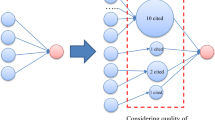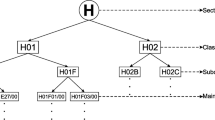Abstract
Patents represent the technological or inventive activity and output across different fields, regions, and time. The analysis of information from patents could be used to help focus efforts in research and the economy; however, the roles of the factors that can be extracted from patent records are still not entirely understood. To better understand the impact of these factors on patent value, machine learning techniques such as feature selection and classification are used to analyze patents in a sample industry, nanotechnology. Each nanotechnology patent was represented by a comprehensive set of numerical features that describe inventors, assignees, patent classification, and outgoing references. After careful design that included selection of the most relevant features, selection and optimization of the accuracy of classification models that aimed at finding most valuable (top-performing) patents, we used the generated models to analyze which factors allow to differentiate between the top-performing and the remaining nanotechnology patents. A few interesting findings surface as important such as the past performance of inventors and assignees, and the count of referenced patents.


Similar content being viewed by others
References
Albert, M. B., Avery, D., Narin, F., & McAllister, P. (1991). Direct validation of citation counts as indicators of industrially important patents. Research Policy, 20, 251–259.
Baldini, N., & Grimaldi, R. (2007). To patent or not to patent? A survey of Italian inventors on motivations, incentives, and obstacles to university patenting. Scientometrics, 70, 333–354.
Braun, T., Schubert, A., & Zsindely, S. (1997). Nanoscience and nanotechnology on the balance. Scientometrics, 38, 321–325.
Breiman, L. (2001). Random forests. Machine Learning, 45, 5–32.
Breitzman, A. F., & Mogee, M. E. (2002). The many applications of patent analysis. Journal of Information Science, 28, 187–205.
Carpenter, M. P., Narin, F., & Woolf, P. (1981). Citation rates to technologically important patents. World Patent Information, 3, 160–163.
Chen, D., Lin, W. C., & Huang, M. (2007a). Using essential patent index and essential technological strength to evaluate industrial technological innovation competitiveness. Scientometrics, 71, 101–116.
Chen, H., Li, X., & Lin, Y. (2007b). Worldwide nanotechnology development: a comparative study of USPTO, EPO, and JPO patents (1976–2004). Journal of Nanoparticle Research, 9, 977–1002.
Cohen, W. (1995). Fast effective rule induction. In Proceedings of the twelfth international conference on machine learning (pp. 115–123). San Mateo: Morgan Kaufmann Publishers.
Connolly, R. A., & Hirschey, M. (1988). Market value and patents: A Bayesian approach. Economics Letters, 27, 83–87.
Debackere, K., Verbeek, A., Luwel, M., & Zimmermann, E. (2002). Measuring progress and evolution in science and technology-II: The multiple uses of technometric indicators. International Journal of Management Reviews, 4, 213–231.
Domingos, P. (1999). MetaCost: A general method for making classifiers cost-sensitive. In Proceedings of the fifth international conference on knowledge discovery and data mining (pp. 155–164). New York: ACM Press.
Gay, C., & Le Bas, C. (2005). Uses without too many abuses of patent citations or the simple economics of patent citations as a measure of value and flows of knowledge. Economics of Innovation and New Technology, 14, 333–338.
Griliches, Z. (1990). Patent statistics as economic indicators: A survey. Journal of Economic Literature, 28, 1661–1707.
Gupta, V. K. (1999). Technological trends in the area of fullerenes using bibliometric analysis of patents. Scientometrics, 44, 17–31.
Hagedoorn, J., & Cloodt, M. (2003). Measuring innovative performance: Is there an advantage in using multiple indicators? Research Policy, 32, 1365–1379.
Hall, B. H., Jaffe, A., & Trajtenberg, M. (2005). Market value and patent citations. RAND Journal of Economics, 36, 16–38.
Harhoff, D., Narin, F., Scherer, F. M., & Vopel, K. (1999). Citation frequency and the value of patented innovation. Review of Economics and Statistics, 81, 511–515.
Hilario, M. & Kalousis, A. (2000). Quantifying the resilience of inductive classification algorithms. In Proceedings of the 4th European conference on principles of data mining and knowledge discovery (pp. 106–115). France: Lyon.
Huang, Z., Chen, H., Chen, Z. K., & Roco, M. C. (2004). International nanotechnology development in 2003: Country, institution and technology field analysis based on USPTO patent database. Journal of Nanoparticle Research, 6, 325–354.
Huang, Z., Chen, H., Li, X., & Roco, M. C. (2006). Connecting NSF funding to patent innovation in nanotechnology (2001–2004). Journal of Nanoparticle Research, 8, 859–879.
Huang, Z., Chen, H., Yip, A., Ng, G., Guo, F., Chen, Z.-K., et al. (2003). Longitudinal patent analysis for nanoscale science and engineering: Country, institution and technology field. Journal of Nanoparticle Research, 5, 333–363.
Hullmann, A. (2007). Measuring and assessing the development of nanotechnology. Scientometrics, 70, 739–758.
Hullmann, A., & Meyer, M. (2003). Publications and patents in nanotechnology: An overview of previous studies and the state of the art. Scientometrics, 58, 507–527.
John, G. H. & Langley, P. (1995). Estimating continuous distributions in Bayesian classifiers. In Proceedings of the eleventh conference on uncertainty in artificial intelligence (pp. 338–345). San Mateo: Morgan Kaufmann Publishers.
Karki, M. (1997). Patent citation analysis: A policy analysis tool. World Patent Information, 19, 269–272.
Kononenko, I. (1994). Estimation attributes: analysis and extensions of RELIEF. In Proceedings of the 1994 European conference on machine learning (pp. 171–182). San Mateo: Morgan Kaufmann Publishers.
Kostoff, R. N., Koytcheff, R. G., & Lau, C. G. Y. (2007). Global nanotechnology research metrics. Scientometrics, 70, 565–601.
Kostoff, R., Stump, J., Johnson, D., Murday, J., Lau, C., & Tolles, W. (2006). The structure and infrastructure of the global nanotechnology literature. Journal of Nanoparticle Research, 8, 301–321.
Le Cessie, S., & Van Houwelingen, J. C. (1992). Ridge estimators in logistic regression. Applied Statistics, 41, 191–201.
Lee, L. L., Chan, C. K., Ngaim, M., & Ramakrishna, S. (2006). Nanotechnology patent landscape 2006. Nano, 1(2), 101–113.
Leydesdorff, L., & Meyer, M. (2007). The scientometrics of a Triple Helix of university–industry–government relations. Scientometrics, 70, 207–222.
Lo, S.-C. (2008). Patent coupling analysis of primary organizations in genetic engineering research. Scientometrics, 74, 143–151.
Marinova, D., & Mcaleer, M. (2003). Nanotechnology strength indicators: International rankings based on US patents. Nanotechnology, 14, R1–R7.
Meyer, M. (2001). Patent citation analysis in a novel field of technology: An exploration of nano-science and nano-technology. Scientometrics, 51, 163–183.
Meyer, M. (2007). What do we know about innovation in nanotechnology? Some propositions about an emerging field between hype and path-dependency. Scientometrics, 70, 779–810.
Meyer, M., & Persson, O. (1998). Nanotechnology-interdisciplinarity, patterns of collaboration and differences in application. Scientometrics, 42, 195–205.
Narin, F. (1993). Technology indicators and corporate strategy. Review of Business, 14, 19–23.
Narin, F. (1994). Patent bibliometrics. Scientometrics, 30, 147–155.
Narin, F., Breitzman, A. F., & Thomas, P. (2004). Using patent citation indicators to manage a stock portfolio. In H. F. Moed, W. Glänzel, & U. Schmoch (Eds.), Handbook of quantitative science and technology research: The use of publication and patent statistics in studies of S&T systems (pp. 553–568). Netherlands: Springer.
Narin, F., & Hamilton, K. S. (1996). Bibliometric performance measures. Scientometrics, 36, 293–310.
Quinlan, R. (1993). C4.5: Programs for machine learning. San Mateo: Morgan Kaufmann Publishers.
Reitzig, M. (2003). What determines patent value? Insights from the semiconductor industry. Research Policy, 32, 13–26.
Rozhkov, S., & Ivantcheva, L. (1998). Scientometrical indicators of national science & technology policy on patent statistics data. World Patent Information, 20, 161–166.
Sampat, B. (2004). Examining patent examination: An analysis of examiner and applicant generated prior art. Working Paper, School of Public Policy, Georgia Institute of Technology.
Tong, X., & Frame, J. D. (1992). Measuring national technological performance with patent claims data. Research Policy, 23, 133–141.
Trajtenberg, M. (1990). A penny for your quotes: Patent citations and the value of innovations. RAND Journal of Economics, 21, 172–187.
Trippe, A. J. (2003). Patinformatics: Tasks to tools. World Patent Information, 25, 211–221.
Van Looy, B., Debackere, K., Callaert, J., Tussen, R., & Van Leeuwen, T. (2006). Scientific capabilities and technological performance of national innovation systems: An exploration of emerging industrial relevant research domains. Scientometrics, 66, 295–310.
Van Someren, M., & Urbancic, T. (2005). Applications of machine learning: Matching problems to tasks and methods. Knowledge Engineering Review, 20, 363–402.
Verbeek, A., & Debackere, K. (2006). Patent evolution in relation to public/private R&D investment and corporate profitability: Evidence from the United States. Scientometrics, 66, 279–294.
Verbeek, A., Debackere, K., Luwel, M., & Zimmermann, E. (2002). Measuring progress and evolution in science and technology-I: The multiple uses of bibliometric indicators. International Journal of Management Reviews, 4, 179–211.
Wallin, J. A. (2005). Bibliometric methods: Pitfalls and possibilities. Basic & Clinical Pharmacology & Toxicology, 97, 261–275.
Wang, S. (2007). Factors to evaluate a patent in addition to citations. Scientometrics, 71, 509–522.
Witten, I. H., & Frank, E. (2005). Data mining: Practical machine learning tools and techniques (2nd ed.). San Francisco: Morgan Kaufman Publishers.
Author information
Authors and Affiliations
Corresponding author
Rights and permissions
About this article
Cite this article
Bass, S.D., Kurgan, L.A. Discovery of factors influencing patent value based on machine learning in patents in the field of nanotechnology. Scientometrics 82, 217–241 (2010). https://doi.org/10.1007/s11192-009-0008-z
Received:
Accepted:
Published:
Issue Date:
DOI: https://doi.org/10.1007/s11192-009-0008-z




